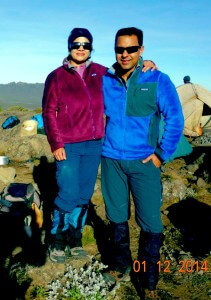“You never conquer the mountain, You only conquer yourself.”
Climbing Mt. Kilimanjaro, the world’s highest free standing mountain, is quite an experience – a “Eulogy Moment” really (will expand on that in a later post). I had expected it would be, so I took the time to ponder on my reflections during the climb. At the end of it, I was left with valuable life and business lessons:
1. Fear vs Danger
Did you know that 8-15 people die every year on Mt. Kilimanjaro? Knowing this statistic before going is certainly fear inducing, but it also forces one to put fear in perspective. Instead of dwelling on the fear, which is time consuming and disconcerting, I spent most of my energy preparing for danger – and this was far more productive.
“Everything you want is on the other side of fear” – according to The Power of Focus – or more topically from the movie ‘After Earth’:
“Fear is not real. The only place that fear can exist is in our thoughts of the future. It is a product of our imagination, causing us to fear things that do not at present and may not ever exist. Do not misunderstand me, danger is very real, but fear is a choice.”
Lesson #1: Don’t fear danger, prepare for it. Danger is real, but fear is something you’re creating/absorbing.
2. Over-preparation Should Not Spill Over to ‘Over-thinking’
Preparation does not mean seeking out every horror story and studying what they did wrong and why. Negative events, particularly horror stories, receive a disproportionate amount of attention and can discourage your efforts if you let them. Plane crashes get tons of attention, naturally – but did you know that 13 people perish each year from vending machines falling on them? Probably not. And the less you know about such freak accidents, the better.
In explorations and journeys dating back centuries, many explorers were prepared with food, medicines and such – but most were surprised by how tough the journey actually turned out to be. Had they known what they were getting into, many may not have made the attempt.
For me, just because fit people like Martina Navratilova and famed Everest mountaineer Ian Mckeever didn’t make it to the top of Mt. Kilimanjaro, it didn’t mean I wouldn’t – but I didn’t read about their horrifying failed attempts until after I got back.
Lesson #2: Over-preparation is key, but don’t get lost in it.
3. A Small Group Is Sometimes Best
Think about the size of your team. If you regularly meet with or have more than seven direct reports, how well do you get to know these folks? And how enjoyable – or productive – is it when you all get together?
When climbing a mountain, having seven people in your group is large enough for camaraderie and small enough to get to know each other. And this translates to business scenarios as well. If the group is too large, there’s no bonding – and if it’s too small, there’s no energy. Also, let’s be honest – how can one person successfully partner with or mentor more than seven direct reports? You can’t.
Lesson #3: Keep teams – and reporting structures – small, for big returns.
4. Aim Small, Miss Small
Navy Seals got it right. No matter what they do, they break goals into smaller chunks – by day, even by hour. And you should too.
Having clearly defined and specific small term goals – like “reach that ridge in the next two hours” – may not seem like a grand vision, but before you know it, you have completed a five and a half day ascent up to almost 20,000 feet (Or conquered a seemingly insurmountable business goal.) It’s all in the planning.
Lesson #4: Break goals into clearly defined manageable chunks and you WILL complete them.
5. Slow And Steady Finishes The Race
Those who start best don’t always finish best – or at all. Many groups rushed ahead of us on summit day, and many were ultimately evacuated because they ascended too fast and it caused faster AMS (Altitude Mountain Sickness).
As with most things in life, consistency and persistence worked best as a long-term strategy. And when unplanned spurts of growth or activity happen naturally, you’ll be better acclimated to your environment and able to take them in stride. This applies to one’s business vision as well, of course.
Jobs once famously said “We have to let go of this notion that for Apple to win, Microsoft has to lose”. They just needed to find a way for them to win somewhere, separately.
Lesson #5: Race only against yourself and you’ll be centered and ready for anything.
6. Don’t Miss Out On The ‘Permanent Present’
When you look back on an event, you really can’t recapture the moment because the way one feels today changes the way we remember things.
When I was climbing Mt. Kilimanjaro, I wasn’t preoccupied with how awesome it was going to be to reach the summit, I understood the steps I was taking toward the summit were equally fantastic and worth paying attention to. If you’re interested in this topic, you will love famed philosopher Alan Watts’ analogy of Life as not a journey (A to B), but as music.
So whether it’s climbing a mountain, spending time with your kids, or creating the world’s best products, try to enjoy the moment you’re actually doing it, aptly called the ‘permanent present.’
Lesson #6: Small steps count – today counts – pay attention to it.
What other life lessons would you add to this list? To learn more about how Heartwood’s culture is impacted by these – and other – life experiences, check out our ‘founding principles’ series.
Photo credit: Our dearest friend and fellow climber Sridevi Koneru.




